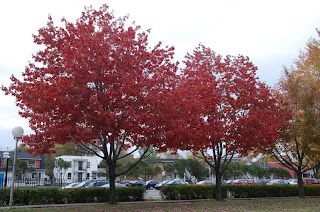View Mauritius in a larger map
Melbourne Airport does not have a curfew and it is not unusual to leave around midnight, but our plane was delayed and we did not leave until 2.45 a.m. Perhaps it was just as well we were pretty sleepy as Air Mauritius Economy is real cattle class! We had 200 km/hr head winds which made Melbourne - Mauritius a 12 hour flight, but being so tired I was able to sleep.
The airport is in the south of the island, but our hotel, Trou aux Biches is in the north, so we started with a drive through sugarcane fields as we made our way from the south east to the north west of the island. There was a good motorway from the Airport to Port Louis the capital. However once we reached Port Louis there was an amazing amount of traffic. Perhaps I should not have been surprised as although the island is only ~2000 sq kms, the population is over 1.25m. We drove past the Prime Minister's Office. There was a notice on the door identifying it and no barricades, which I took to be a good sign - indicating little tension. I understand Mauritius is one of the best governed countries in Africa, although that is faint praise!
Trou aux Biches is a nice older style resort hotel with thatched cottages set in lovely gardens which run down to a long sandy beach.
After lunch we visited the Pamplemousses Gardens (more correctly, the Sir Seewoosagur Ramgoolam Botanical Gardens at Pamplemousses), so named because they were established with the aim of growing grapefruit to supply passing ships. Now amongst a host of plants and trees they have an outstanding collection of palms.
In the evening as the sun set we were entertained by La Sega dancers on the beach. African slaves introduced this dance. The music is provided by goatskin drums, rattles and triangles.
On Thursday after a breakfast by the sea and a stroll along the beach we left on a tour of the island visiting the memorial to Matthew Flinders at Baie du Cap and then onto Chamarel and lunch at a restaurant with a spectacular view. We continued on up into the Central Plateau. The only coffee plantation in Mauritius is here. Other crops around here are pineapples, bananas, heart and oil palms. We noted some wealthy colonial homes. The climate on the Central Plateau is more pleasant and hence those who can afford it, live up here rather than in Port Louis
Unfortunately the rest of our sightseeing was rained out. We could see little through the mist and rain.
Luckily, Friday was a better day and we went to the markets in Port Louis before we left for Madagascar. There was a wide variety of good fruit and vegetables as well as dried fish and lots of spices.
Coming into land at Mauritius. Joseph Conrad called it a pearl of the ocean and Mark Twain wrote that heaven had been copied from Mauritius (or words to that effect). Matthew Flinders probably did not share these sentiments during his long imprisonment on the island.
In 1810, the British wrested control of Mauritius from the French. So today, the traffic drives on the left and the road signs are in English, but Creole is the most widely spoken language and newspapers and other media are mostly in French.
Looking along the beach at Trou aux Biches
Sega dancing at sunset. Traditionally the feet do not leave the ground
Palms in the gardens of our hotel
Giant Victoria amazonica water lilies in the Pamplemousses Gardens
Madagascar Fody.
Chamarel coloured earths
Chamarel Falls
Hindu deities at Grand Bassin. Shiva and his wife Parvati were dazzled by the beauty of Mauritius and spilt some water from the Ganges in this crater lake and up to 500,000 Hindus make a pilgrimage here every year.
Street scene near the Central markets
Fresh vegetables in the Central markets
Icecream for anyone?


























